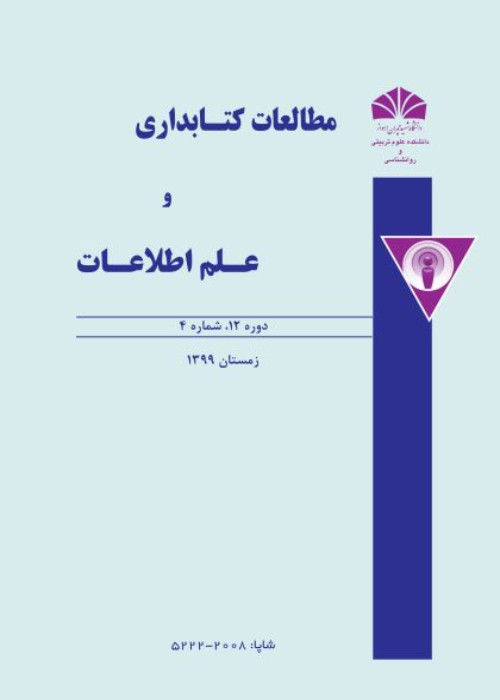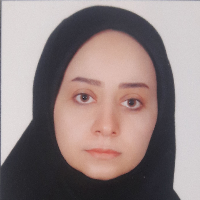Children and information: what are Children Information needs?
Author(s):
Article Type:
Research/Original Article (دارای رتبه معتبر)
Abstract:
Abstract Background and Objectives
Childhood conditions require special care and attention, believing that family, friends, environment, media could be all considered as environmental factors and motives that are related to the child and may affect all related affairs, activities, needs and other matters related to it. These factors can play a very important role in shaping, directing and meeting the needs of children. The child needs to grow in a normal environment, have the necessary support and assistance so as he/she can assume his responsibilities in society and prepare for living as a member of the community. In the process of the child’s learning, many adults are involved. They provide necessary information for the child, so they can play an effective role. The first and most important group is parents who are in direct contact with the child all the time and interact with him/her more than everybody and, of course, will play a greater role in this direction. By knowing children's information needs, they can try to provide children with the necessary information in a variety of ways.
Methodology
The main purpose of this research is reviewing and categorizing children information needs. According to the Convention of the Rights of the Child (CRC), children means up to 18 years old. This research use review-analytical method. First part reviewed researches which focused on children information needs. Much of the research is based on Maslow pyramid. Considering the limitations of access to foreign and international research database, extensive search was made at accessible databases. "information needs" was used as keyword and search was limited using "child", "children", "kids" and "young adult". The articles which paid attention to categorizing information needs of children were considered. Most articles were English and few were Persian. Some of articles which did not provide access to their full text, were requested through a document supply system, some of which were provided and studied. Some of articles were provided by contacting authors and received by email.
Findings
A limited number of articles were received by email to the corresponding authors. A few articles were not provided in the ways mentioned, so their study was not provided. These studies are divided into two groups: some of them have focused on children's information needs (for example Farrell (1974), Fourie (1995) and Palaniandy (1998) and the other part specifically defines the information needs of children in different classify. In 1973, a conference was held on the occupational needs of ethnic groups and other groups in the United States. One of the focuses of this conference was to consider the information needs of children and adolescents as a specific group. Walter (1994) went to California, Los Angeles and Santa Barbara to research about children's information needs. Because there is a presumption that the information needs of children are mainly examined by the elderly, the researcher decided to collect the required data from the elderly. Walter in this study found out that the results of his research were very much coherent with Maslow’s pyramid of basic human needs. Walter's findings suggest that children will experience the following information needs during their childhood: self-fulfillment, credit, love and belonging, security. Herman (2010), in his research on the information needs of children, offers the following categories of children's information needs: school related information needs, entertainment and leisure related information needs, personal information needs (problems that the person is involved in, medications, family conditions), information needs of specific individuals (such as children, intelligent children, people with disabilities, people with special problems, multilingualism, indigenous people who are not able to speak in the official language of that area). A review of the research that has been done so far has shown that most studies have focused on Maslow's basic needs for the information needs of children. One of the most important work that has been done to identify the needs of children on a global scale so far has been the Convention on the Rights of the Child, adopted in Geneva in 1959. This article is based on Convention of the Rights of the Child and notify categories of children information needs which are related to: survival and life; social security and quality of life; self-support, abuse prevent; personal and family relationship, friendship; freedom of expression and thought; religious; books, informative sources, media and social networks; health; specialized training; self-esteem, personal and social dignity. Focusing on the nature of children information needs will help public librarians in collection development for children.
Discussion
This research showed that needs to know about survival and life, social security and quality of life is one of the most important needs of children, article 26 in CRC was mentioned it. It will be so necessary in puberty and adolescence age. Child needs Information about self-support (article 3 in CRC), abuse prevent (articles 32-37 in CRC) for better deciding about child labor and economic exploitation, drug dealing, children's sales and torture. Information need about personal and family relationship and friendship (articles 9 in CRC) are important for social relations and detecting friends. Children needs to know about freedom of expression and thought (articles 13 and 14 in CRC). Child needs to know about religious (article 14 in CRC) and so he will need religious book, people and place. Information needs about books, informative sources, media and social networks (article 17 in CRC) is important. They need to know about national and international information resources and how to use them. Child needs information about health (article 24 in CRC). Child needs to know about sickness, how we get sick, what should we do with sick people. They need information about specialized training (article 28 in CRC). So teachers can play an important role and school is the best information texture. Child needs some information about entertainment and leisure (article 31 in CRC). They need to know how entertain themselves and how spare their time. Having information about self-esteem (article 29 in CRC), personal and social dignity will help children to know that they are also worthy of respect and have the right to object.Language:
Persian
Published:
Journal of Studies in Library and Information Science, Volume:11 Issue: 1, 2019
Pages:
1 to 22
magiran.com/p2009972
دانلود و مطالعه متن این مقاله با یکی از روشهای زیر امکان پذیر است:
اشتراک شخصی
با عضویت و پرداخت آنلاین حق اشتراک یکساله به مبلغ 1,390,000ريال میتوانید 70 عنوان مطلب دانلود کنید!
اشتراک سازمانی
به کتابخانه دانشگاه یا محل کار خود پیشنهاد کنید تا اشتراک سازمانی این پایگاه را برای دسترسی نامحدود همه کاربران به متن مطالب تهیه نمایند!
توجه!
- حق عضویت دریافتی صرف حمایت از نشریات عضو و نگهداری، تکمیل و توسعه مگیران میشود.
- پرداخت حق اشتراک و دانلود مقالات اجازه بازنشر آن در سایر رسانههای چاپی و دیجیتال را به کاربر نمیدهد.
دسترسی سراسری کاربران دانشگاه پیام نور!
اعضای هیئت علمی و دانشجویان دانشگاه پیام نور در سراسر کشور، در صورت ثبت نام با ایمیل دانشگاهی، تا پایان فروردین ماه 1403 به مقالات سایت دسترسی خواهند داشت!
In order to view content subscription is required
Personal subscription
Subscribe magiran.com for 70 € euros via PayPal and download 70 articles during a year.
Organization subscription
Please contact us to subscribe your university or library for unlimited access!




